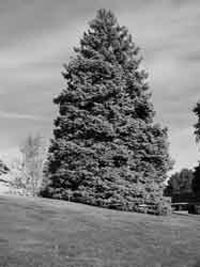Resource Library
Plant of the Week: Spruce, Blue
The University of Arkansas System Division of Agriculture does not promote, support or recommend plants featured in "Plant of the Week." Please consult your local Extension office for plants suitable for your region.
Plant of the Week
Blue Spruce
Latin: pica pungens

In a way landscape trees are a kind of time machine, transporting us back to the period when they were planted. By gazing at them you can glimpse the choices arrayed before the homeowner as they chose the trees for their residence. Just as planters grow old and die, so do trees. As these older trees succumb, a portal to the past closes as they are replanted with the trees of current fashion.
One of the trees one hardly ever encounters today is the Colorado Blue Spruce, Picea pungens. In the 1920's and 1930's it was a tree that proclaimed, "we’ve made it," a kind of silvan status symbol.
The blue spruce is a coniferous evergreen with layered branches that decrease in length as they ascend the 60-foot trunk, giving the tree a perfect symmetrical form. In the western mountains where it grows, mostly 6,000 to 10,000 feet from Yellowstone to northern New Mexico, it usually has green needles and the somber character of most spruces in a forest setting.
But some trees - especially those confined to high, dry places - develop a waxy bloom on their inch long needles that turn the tree a gorgeous blue that makes it highly prized as a landscape specimen. This waxy bloom is produced by glands on the needle surface and can be rubbed off, revealing a typical green leaf beneath.
To skiers in Colorado, the evergreens on the slopes look more or less alike. But, thanks to the efforts of a St. Louis doctor named George Engleman (1809-1884), the world learned of the two spruces that inhabit that region, the Engleman spruce and the Blue spruce.
Engleman immigrated to the United States in 1832 and eventually established a medical practice in the rapidly expanding city. While earning his living in medicine, botany was his passion and as often as possible he would take extended trips into the unexplored parts of the desert southwest and into the Rockies. He is probably best known for his work with cacti, but his work with conifers is equally significant.
He was the first botanist to describe the blue spruce and was no doubt involved in the first seed collection project that occurred in 1862. German and Dutch nurserymen were especially fond of the tree and by the end of the century were making selections of the bluest types and selling grafted clones. The first and still one of the best of these was ‘Koster’ blue spruce that was released by a Dutch nursery in 1901.
American nurserymen used a simpler technique. They planted seeds and selected the bluest seedlings for growing on to salable sizes. After the trust-busting legislation of the Teddy Roosevelt administration, there was a general redistribution of wealth and the middle class expanded. Homes were first on the list of acquisitions for many of these newly well-to-do families.
The largest conifer grower in the nation during the post WW I period describes the blue spruce as the ultimate status symbol for the era. For the less-well-off, seedlings with less blue color could be had very cheaply. For those of moderate income the bluest seedlings could be purchased. For the well heeled, the grafted selections imported from European nurserymen were available.
But after WWII the nursery industry began changing and container production became more important. Blue spruce did not readily adapt to growing in containers in warm climates, so it lost ground to plants better suited to the new market direction.
Blue spruce is only adapted in the higher elevations of Arkansas, and even then it suffers from our heat and humidity. In the wilds of Colorado it may live to be 700 years old, but in landscape situations it usually becomes so ratty looking by its 60th year that it is taken down. It must be in full sun with a reasonably fertile, well-drained soil. It should be watered during dry spells. Bagworms are the most serious pest of the tree, but like most trees grown out of its natural range, a host of other ailments can afflict it.
By: Gerald Klingaman, retired
Extension Horticulturist - Ornamentals
Extension News - January 10, 2003
The University of Arkansas System Division of Agriculture does not maintain lists of retail outlets where these plants can be purchased. Please check your local nursery or other retail outlets to ask about the availability of these plants for your growing area.